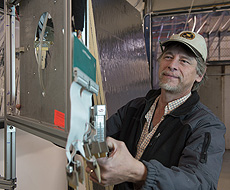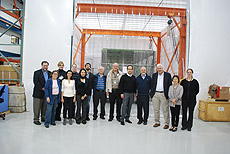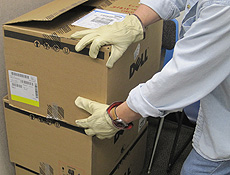|
Have a safe day!
Monday, Oct. 22
2:30 p.m.
Particle Astrophysics Seminar - One West
Speaker: Alexander Belikov, Institut d'Astrophysique de Paris
Title: Indirect Detection of Dark Matter at GeV and TeV Scales
3:30 p.m.
DIRECTOR'S COFFEE BREAK - 2nd Flr X-Over
THERE WILL BE NO ALL EXPERIMENTERS' MEETING THIS WEEK
Tuesday, Oct. 23
3 p.m.
LHC Physics Center Topic of the Week Seminar - WH11NW
Speaker: Ted Liu, Fermilab
Title: Overview of Trigger in HEP: The View from Physics
3:30 p.m.
DIRECTOR'S COFFEE BREAK - 2nd Flr X-Over
THERE WILL BE NO ACCELERATOR PHYSICS AND TECHNOLOGY SEMINAR TODAY
Click here for NALCAL,
a weekly calendar with links to additional information.
Ongoing and upcoming conferences at Fermilab |
| Monday, Oct. 22
- Breakfast: pancake sandwich
- Italian minestrone
- Philly chicken sandwich
- Spaghetti and meatballs
- Smart cuisine: herbed pot roast with vegetables
- Garden beef wrap
- Assorted pizza
- Creole jambalaya
Wilson Hall Cafe Menu
|
|
Wednesday, Oct. 24
Lunch
- Rouladen
- Egg noodles with dill
- Glazed carrots
- Apple walnut cake
Friday, Oct. 26
Dinner
Closed
Chez Leon Menu
Call x3524 to make your reservation.
|
|
Today's network outage
Shortly after today's planned power outage at 7 a.m., a fire suppression system was triggered in the Feynman Computing Center. This resulted in an unplanned extension of the power outage, which affected the Fermilab network. There is no evidence of a fire at the FCC. The cause for the fire suppression system being triggered is under investigation.
|
One minute with Todd Nebel, PPD mechanical operations specialist
 |
Todd Nebel, PPD, is hard at work at the Fermilab Test Beam Facility. Photo: Reidar Hahn
|
How long have you been at Fermilab?
I've been here for 32 years. I started right out of high school.
Describe a typical workday.
I do just about anything from A to Z in a given day. I'll work on anything from basic mechanics, something like twisting a wrench, to more technical work, like trying to design a new detector for a user.
For over 10 years now, I've been working on upgrading the Test Beam Facility. When I was hired for this project, only one user was taking data with beam. Now we have anywhere from four to six groups come in each month and stay for about a week.
I work to make it easier for users to take data. For example, I designed a set of carts with thousands of cables attached so that users can easily bring the cables to where they need them. Before, all the cables were attached to a large wall and it would take hours and a large crane to move the wall and cables, whereas now it takes just a few minutes.
What's the best part of your job?
Working with all of the physicists.
About every week or so there's a new group of physicists that comes through the Test Beam Facility, and each one has something different and unique they want to install and set up.
There are so many different types of physicists and so many different projects here at Fermilab, and each one brings new challenges to the lab, which keeps it interesting. Plus it's like getting a new batch of friends every few weeks.
What do you enjoy doing outside of work?
Playing in my backyard. I have lots of fruit trees and several gardens to tend to, as well as more than a dozen chickens and two dogs, so I end up with lots to do there.
What's something people may not know about you?
In 1990 I was part of a paintball team that won the World Championships. At the same time, we were awarded "most honorable team" because one of our opponent team's guns wasn't working, so we lent them some of ours.
—Jessica Orwig
If there is an employee you'd like to see profiled in an upcoming issue of Fermilab Today, please e-mail today@fnal.gov.
|
DOE and NSF members tour MicroBooNE facilities
 |
On Saturday, Oct. 13, members of the U.S. Department of Energy and the National Science Foundation toured Fermilab's MicroBooNE facilities. Here they stand in front of the MicroBooNE time projection chamber. Pictured, from left: Ted Lavine (DOE), Gina Rameika (Fermilab), Sam Zeller (Fermilab), Georgia Karagiorgi (Columbia), Sarah Lockwitz (Fermilab), Roxanne Guenette (Yale), Jonathan Asaadi (Syracuse), Jim Whitmore (NSF), Tim Bolton (DOE), Saul Gonzalez (NSF), Pier Oddone (Fermilab), Jim Siegrist (DOE), Young-Kee Kim (Fermilab), Bonnie Fleming (Yale). Photo courtesy of Jim Whitmore, NSF
|
|
Cosmic rays eyed to locate nuke fuel melt
From The Japan Times, Oct. 19, 2012
WASHINGTON — Researchers from Los Alamos National Laboratory have developed a method to use cosmic rays to locate molten nuclear fuel within the crippled reactors at the Fukushima No. 1 nuclear power plant, the U.S. institute said Wednesday.
Monitoring data for a month or two by placing a pair of muon particle detectors in front of and behind the reactor buildings and the containment vessels will provide detailed images of the inside of the damaged reactors, it said.
A team from the New Mexico-based laboratory visited the Fukushima plant in May and confirmed they were able to place the detectors — about 3 to 5 meters wide and tens of centimeters thick — near the damaged reactors 1 and 2.
Read more
|
|
Practice proper hand safety: wear protective gloves
 |
Protect your hands so they last a lifetime. Wear gloves appropriate to the task. Photo: Joel Kofron, ES&H |
Hand injuries are always a concern as we work at home and at Fermilab. We use our hands frequently and thus have many opportunities to pinch, cut, burn or crush them inadvertently. Often these types of injuries can be avoided by wearing proper gloves.
For certain assignments, one may need specialized gloves to be adequately protected without adversely affecting the work process. For example, for tasks that require making fine adjustments, people often remove their gloves to get the job done, but this has resulted in worker injuries. A solution would be to wear tight-fitting mechanic's gloves, which are now available in the Fermilab stock room. Although mechanic's gloves tend to provide somewhat less protection than heavy leather gloves, workers are more likely to wear them because of their superior dexterity and comfort.
Hand safety can also be improved by using purpose-specific cutting and ergonomic tools. It can be difficult to ensure the safety of home-made tools, so when you have a choice, use off-the-shelf equipment. The Fermilab stock room offers a large variety of work gloves. Some examples are cut-resistant, mechanic's, knuckle, disposable and heat-resistant gloves.
When performing a manual task, always ask yourself the following three questions:
- Are your hands placed correctly? Consider sharp edges, pinch points and crush zones. Also consider how best to handle hot or cold surfaces. Think especially carefully about where to place your hands when using unguarded machinery.
- Are you observing safe practices? Only perform tasks for which you have been properly trained, and observe any relevant lockout, tag-out procedures. When performing manual tasks, remove all rings and bracelets, and make sure the appropriate guards and barriers are in place. In cases for which a tool will do the job, use it – don't rely on your hands.
- Are you adequately protected? Do not wear worn-out or damaged gloves. For situations in which there's a risk of your hands getting crushed, use gloves with padded crush protection. When using rough equipment, wear leather gloves. For tasks involving harsh or toxic chemicals, use chemical gloves. Use medical gloves in medical situations.
For more information, view this video on safety gloves.
Remember, whether at home or at work, take five and protect your hands and fingers. You don't know how much you need them until you don't have the use of them.
—J.B. Dawson
|
403(b) maximum contributions to increase for 2013
Effective Jan. 1, 2013, 403(b) participants can contribute a maximum of $17,500 (an increase from $17,000 in 2012) to their supplemental retirement plan for the 2013 calendar year.
Employees age 50 and older, or employees who will become age 50 at any time during 2013, may make elective deferred contributions beyond the $17,500 limit in 2013—an additional $5,500. The limit for the catch-up contribution did not increase for 2013 and will apply only to those employees who are making the maximum contribution of $17,500.
For more information, visit http://wdrs.fnal.gov/benefits/403b.html.
|
|